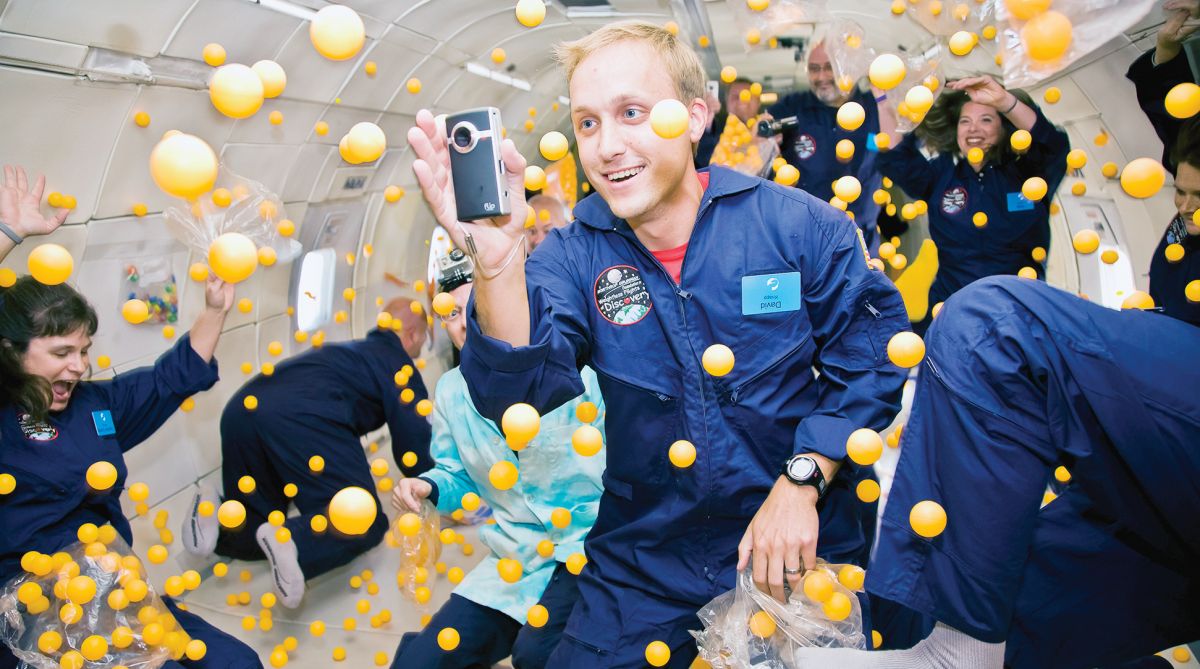Long distance space flight has a huge challenge of load. As there is a limit to the quantity of supplies that can be carried, resources need to be recycled. Doing this with the help of the Sun’s energy or starlight would conserve fuel. We now have the technology to use light energy to split water into hydrogen and oxygen. The method that is available and which works here, on the surface of the Earth, however, makes use of the force of gravity to be effective.
Katharina Brinkert, Matthias H Richter, Omer Akay, Janine Liedtke, Michael Giersig, Katharine T Fountaine and Hans Joachim Lewerenz from Caltech, ESA in the Netherlands, Brandenberg University, Freie University in Berlin, South China Normal University and the Northrop Grumman Corpn, California, report in the journal, Nature Communications, a method of artificial photosynthesis, where light gets water to split into hydrogen and oxygen, to provide both a fuel and oxygen for the crew, in zero gravity conditions. The group has then tested the method in a capsule that experienced near weightlessness when it was launched into a 9.3 second-long free fall in a special facility in Germany.
Advertisement
All the stored energy on Earth is what green plants have captured from sunlight and converted into carbohydrates. The process, called photosynthesis, is how plants grow and produce fruit and grain. Our fossil fuels of coal and petroleum contain the same plant matter preserved since ages.
Green plants, with the help of chlorophyll, are able to extract carbon and hydrogen from carbon dioxide and water, to form carbohydrates and release oxygen. The process has now been understood as a two-step process — the first when the photon of light splits water into ionised hydrogen atoms and an oxygen atom, and the second where the hydrogen ions and carbon dioxide combine as carbohydrates.
The process has been replicated and we now have artificial photosynthesis. Carbon dioxide from sources like power plants can now be converted to other forms, with the release of oxygen. The energy that is necessary to separate the carbon and the oxygen, in the artificial method, is provided by light and silicon-based photocells. The same process can also split water to provide hydrogen and oxygen alone. This is the process that is of interest for space travel.
The problem with the use of photocells in conditions of zero gravity is that for the silicon surfaces, which bring about the splitting of water to be effective, the hydrogen that is generated needs to be swept away. In an Earth-based system, in a water medium, the hydrogen rapidly bubbles to the surface. This happens because of the pressure of the surrounding water, or buoyancy, which arises because of the Earth’s gravity. In outer space, there is no gravity, there would be nothing to push the hydrogen away and hydrogen would crowd the silicon surface as “froth”. The generation of hydrogen and oxygen would then stop as soon as it starts!
It is similar to the condition in the simple electric cell and the vacuum tube valves that were used in early radio sets. In the electric cell, there is a zinc plate and a copper plate imm-ersed in a dilute acid and connected outside the acid with a metal wire. Hydrogen ions, with a positive charge, are released from the water in the dilute acid at the zinc end. Zinc metal moves into the solution and leaves behind a negative charge, which travels through the wire to the copper end as the electric current.
The problem with the simple cell is that the hydrogen released at the zinc end stays put, to cover the zinc plate, and the reaction stops. The more complex electric cells, like the dry cell that we use in portable devices, have arrangements to clear the negative end and keep the cell going for longer.
In the vacuum tube valve, again, there was a negative end, the cathode, where free electrons were generated by heating a coil. The electrons then flowed to the opposite, positive end. But if the poles were reversed, there was no current. This was because the positive end, the anode, was not heated and there were no free electrons.
In addition to this “one-way” effect, the strength of the current could be controlled by a small voltage applied to a mesh, or grid, between the two electrodes. This made the device useful in many ways, the main one being to amplify a feeble signal applied at the grid. But the trouble with the device was that the negative charges released by the heated cathode would collect around it and prevent more charges from moving towards the anode. This collection, which was called the space charge, then needed an arrangement to sweep it away.
In the case of the photocell, when it is used to generate hydrogen in weightless space, again, we need to eliminate the so-called “gas bubble froth”, which covers the active surface. The group writing in Nature Communications provides an answer — architecture for the photocathode that gets the hydrogen bubbles to be released from the surface even without help from any surrounding buoyancy.
The key process is to build a special pattern of nanometre dimensions on the surface. This was done by a printing process called shadow nanosphere lithography — one that has been used elsewhere to generate nanometre surface features. As can be seen in the picture, the electrode surface is covered with nanometre size polystyrene beads.
Gold or silver ions attach to the surface in a pattern that has nanometre dimensions. The nature of the pattern can be varied by changing the angle at which the ions are sprayed or by rotating the grid of polystyrene beads. The second picture shows how the shape generated on the electrode surface keeps the hydrogen from smothering the electrode.
Having found a way that should make the photocathode effective in zero gravity, there was a need to test it. This was done by arranging a sufficiently long spell of freefall. While we all experience gravity by the resistance we feel, when we stand on any surface, we would be weightless if the surface below us was to give way. We would have experienced this when we start the descent in the elevator from the upper floors of a building. Even astronauts are trained to experience weightlessness by spending time in an aircraft that goes into “free fall” descent.
The authors of the paper tested their device in a free fall facility that has been provided for researchers in the town of Bremen in Germany. It consists of a tall tower, 146 metres high, with a 120 metre free fall cavity. The device whose working is to be tested is tossed up using a powerful catapult. As soon as the device leaves the catapult, it is in free fall and weightless, first moving upwards, and then descending. The period of zero gravity is 9.3 seconds.
The device that was flung up has arrangements to test the effectiveness of hydrogen generation from water, using light energy. The test was started as soon as the free fall started and carried on till it ended. The result was that the special electrode surface did allow efficient hydrogen generation despite there being no buoyancy to clear the hydrogen away, the paper reports.
The writer can be contacted at response@simplescience.in











